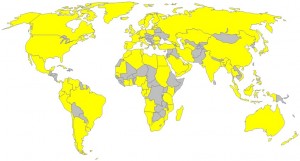100 Country Wildlife Response Profiles and counting

Sea Alarm is very pleased to announce that it has completed and published its 100th Country Wildlife Response Profile. To responders and response planners, these Profiles are broadly respected and often a crucial source of information on each country’s apparent capacity to deal with an oiled wildlife incident.
The Profiles also provide a picture of any remaining challenges that may need to be overcome if responders are mobilized to assist, allowing them to develop a more targeted response.
Country Profiles went into production in 2005, as a routine aspect of Sea Alarm’s developing role as a global adviser on oiled wildlife preparedness and response to the oil industry via its cooperation with Oil Spill Response Limited (OSRL). Sea Alarm’s overall advisory role in oiled wildlife emergencies across the world is to assist with the assessment of local response capabilities and gaps and to provide response management advice, coordination and, if needed, to source international expertise and equipment.
The Profiles were originally used internally by Sea Alarm to pre-assess the capabilities and gaps in countries with increased oil spill risk, but as the number of completed profiles increased, it was decided to make them available to a larger audience. Over the years Sea Alarm has developed its own picture of current levels of oiled wildlife preparedness worldwide, including good practice examples, and has increasingly shared this information with industry, governments, and Regional Agreements. This has enabled Sea Alarm to urge and motivate these parties to invest in and develop their own wildlife response planning arrangements, and to highlight cost-efficient international options and solutions.
Each Profile is produced via online research and contact with in-country stakeholders to capture key information including the names of responsible ministries or departments, the national or regional arrangements for oil spill response and oiled wildlife response, sensitive species and areas, the existence of permanent wildlife facilities and/or expertise for oiled wildlife response.
The Profiles, along with contact details of authorities and stakeholders in each country, are stored in a database, which has grown steadily each year since 2005, resulting in a unique resource to support response to oiled wildlife incidents wherever they may occur. We will continue adding to the list, aiming to complete the picture for all coastal countries in the world and to keep the existing Profiles updated.
The Sea Alarm team would like to thank everyone who has assisted in preparation of the Country Profiles over the years, particularly our US-based consultant Dawn Smith who is currently the driving force behind completion of the Profiles. OSRL’s support is also gratefully received.
As readers, we invite you to take a look at the profile for your country and to please inform Sea Alarm of any updates or corrections. Profiles are published on the Sea Alarm website in the Publications section.

